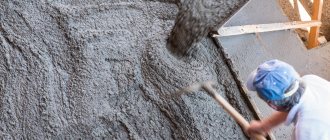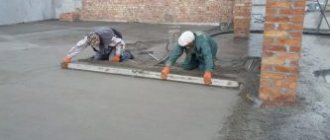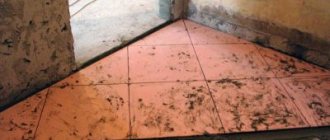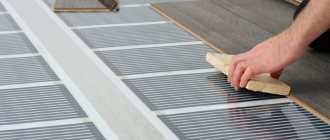Purpose and principle of operation of a construction mixer
One of the most labor-intensive operations is the preparation of concrete mortar and various building mixtures (putty, self-leveling floor). An indispensable assistant in this case will be a concrete mixer. It allows for uniform mixing of the components and, if necessary, maintains the required, easy-to-work consistency of the solution.
In approximate form, the mixer consists of two main parts:
- mixing containers;
- a rotating element that mixes the components and, if necessary, unloads the finished solution.
Mechanization of such a labor-intensive process as preparing concrete mortar can significantly reduce labor intensity and increase labor productivity.
Preparatory work before floor screed.
As already mentioned, if there is a fear of leaks, waterproof it. In bathrooms it is better to use bitumen insulation. Before performing all the work, you need to clear the entire surface of debris, sweep it, and if you have a construction vacuum cleaner, then vacuum it. If waterproofing is done with a solution that covers all the joints and cracks, then after it dries, you need to prime the surface with concrete contact, for better adhesion of the floor slab to the future floor screed. Next, you need to mark and draw the height level of the future floor.
Types of equipment and performance
Today there are a lot of models on the market that allow you to perform different volumes of work. The classification of equipment allows you to decide what types of construction mixers for preparing concrete are:
- drill mixer;
- hand construction mixer;
- mixer cars.
Power
Depending on the engine power, three gradations can be distinguished:
- 500–1000 W;
- 1000–1500 W;
- over 1500 W.
Engine power determines shaft torque and, accordingly, performance. The greater the power, the greater the torque and the lower the rotation speed of the working element. Those. There is a regularity - the larger the single volume of the mixed mixture and the higher its viscosity, the more powerful the model should be used.
The undoubted champion in productivity is mobile automobile installations. Transporting and preparing up to 12 m3 of concrete is a completely feasible task with a mixer truck.
Drill mixer
The most primitive tool is a drill mixer. In fact, it is a regular drill or hammer drill with an auger (mixer) fixed in the chuck. The solution is prepared in a separate container. A bucket, tank or something similar can be used as a container. The components of the mixture are loaded in the required proportions, the tool is connected to the network, turned on and mixes the contents, bringing it to the required consistency.
Disadvantages of the device
This option for preparing concrete mortar can be considered acceptable only in very limited applications. There are several reasons:
- the design of the tool is designed for drilling holes, and not for mixing;
- long continuous operation leads to rapid wear of the motor brushes;
- The low power of the electric motor will not allow preparing any significant amount of solution at the same time.
Hand mixer
A more productive and specialized tool is a concrete manual construction mixer.
Equipment Features
It is partly similar to the previous version, but there are still a number of significant differences:
- more powerful electric motor;
- equipment layout and design that can withstand long-term loads;
- equipped with brackets-limiters, allowing you to focus on the bottom or walls of the mortar container and not hold the tool in your hands.
The work is made easier by the presence of a locking start button on most models. This feature eliminates the need to constantly hold the start button and allows you to hold the tool with both hands by the side handles, easily adjusting its position if necessary.
Nozzles
Mixing of the mixture is carried out using a screw attachment. It can take a variety of forms:
- flat blades;
- spiral blades that ensure mixing of the solution in the upward or downward direction (depending on the direction);
- combination nozzles.
Operating technique
The working methods are absolutely similar to the previous case:
- the components of the mixture in the required weight proportions are loaded into the solution container;
- the required amount of water is added;
- The included mixer mixes the mixture and brings it to the desired state.
In low-power models of concrete mixers, the mortar container, as a rule, has quite small volumes. The finished solution can be unloaded either manually or mechanized. With high productivity in units capable of simultaneously processing up to 10 bags of mixture, unloading is carried out only by mechanization.
The mortar can be supplied to the pouring site using a concrete pump or by gravity, by tipping the mortar container into an inclined chute.
Rating of methods and tools for preparing mortar and concrete
For most construction work: concreting, laying bricks or tiles, pouring screed, etc. a certain amount of ready-made mortar or concrete is required. We list all the tools and methods by popularity.
1. The first place is rightfully occupied by the most affordable and popular hand tool, the shuffle shovel (picking shovel).
Even today at construction sites you can see workers mixing the mortar with shovels and the reason is quite simple, cheap labor from Central Asia. With shovels, if necessary, you can mix, depending on the number of workers, up to several cubes of mortar and concrete. The technology is quite simple, first the materials, cement, sand, crushed stone are poured in an even layer and mixed without water until smooth. You can simply throw the whole pile first in one direction, and then in the other. If two people are working, then you need to stand opposite and move the shovels towards them, then simultaneously lifting them. Once the dry mixture has been mixed, make a hole in the center of the pile, add water and mix further.
Result: suitable for small amounts of work, screeding, plastering, masonry.
Pros: accessibility, minimal investment, exact amount of solution required.
Cons: low productivity, requires a lot of manpower.
2. The second place in popularity is occupied by mortar-concrete units .
Here it is necessary to accurately calculate the required amount of mortar or concrete, place an order with a company engaged in the production and sale of concrete, and at the appointed time, the required amount will be delivered by automixer. All that remains is to accept and pour the concrete in the right place. If it is necessary to supply concrete to the work site, you can use a concrete pump or a crane.
Result: the best choice for large (volume) concrete work, pouring foundations, columns, lintels, etc.
Pros: high productivity, high-quality concrete and pouring entirely at once without breaks, low consumption of human power.
Disadvantages: higher cost, only large volumes from 2 cubic meters and above; if the automixer is idle for more than an hour while you are receiving concrete, you will have to pay extra.
3. In third place is a conventional electric concrete mixer .
We pour into it, in the required proportion, the required amount of building materials, cement, sand, crushed stone, add water. It is important that you either first mix the cement with the dry ingredients and then add water, or pour it into the water while the mixer is rotating, otherwise it will stick to the walls. Rotating, the drum mixes the mixture with the blades located in it and after a few minutes we get a ready-made solution or, if concrete.
Result: suitable for preparing all types of mortars and concretes, except large volumes of concrete. The best option for private construction.
Pros: average productivity, you can make an exact amount of solution. Its light weight and collapsible design allows it to be transported in a regular gazelle.
Cons: to work with a concrete mixer you need to buy it, the cost starts from 7 thousand rubles. and higher, depending on the productivity of the concrete mixer. Concrete mixers with a capacity of 0.75 m2 or more require a voltage of 380v, which is not available at all construction sites.
4. The fourth place is occupied by hand-held electric mixers .
The simplest option is a drill attachment - a mixer. We put it on the drill and mix the solution or putty in the bucket. Do not forget that the drill is not designed for such loads. The load reduces the speed of the drill to a minimum, overheating it and it is better to use a hammer drill instead of a drill. There is also a more serious tool - manual electric mixers, which were originally designed for mixing the solution (the design has a reduction gear).
Result: suitable for preparing mortar in small volumes, for example, for renovations in the kitchen, it also allows you to thoroughly mix mortar and building mixtures for finishing work.
Pros: Low to medium performance depending on the tool, and low-effort mixing.
Cons: using a drill with an attachment can ruin a power tool; specialized hand-held electric mixers cost from 5 thousand rubles. but they are not suitable for mixing concrete, even if the tool has enough power, it is very difficult to hold it with your hands.
5. The fifth and final place goes to folk art products.
Manual concrete mixers , there are quite a few options. They all boil down to attempts to facilitate the mixing of mortar and concrete. The principle is the same as that of electric concrete mixers, only in this version, the role of the electric motor is performed by a person. So the motto suggests itself: It’s better to lose a day, then mix it up in an hour.
Result: no matter what the child enjoys, as long as he doesn’t drink.
Pros: exercise for the body and mind.
Cons: the characteristics are very questionable; in my opinion, you will spend more time and effort than if you simply mix the mortar and concrete with a shovel.
Author: Valery Imenov
Did you like the article? Share the link with your friends on social media. networks:
5 Rating 5.00 [2 vote(s)]
Mobile automixers
Separately, it is worth considering large industrial mixers made on an automobile basis.
These are powerful, productive units that are widely used in construction. They allow you to not only prepare and pour the solution, but are also capable of transporting it over considerable distances.
Unit design
The main working components are the same as those of more modest manual models:
- mortar container;
- screw mixer.
The mortar container is a large, rotating drum and a working element-mixer located inside. It works on the principle of an Archimedean screw. When loading components or the finished solution, the drum rotates, pushing the contents deep into the container. When unloading, the rotation occurs in the opposite direction, and the screw unloads the concrete solution.
Transporting the solution
Reception, as well as unloading of ready-made concrete from a mobile mixer and supplying it directly to the pouring site is carried out using a concrete pump or unloading into inclined chutes assembled from scrap materials.
The use of a concrete pump allows the solution to be transported horizontally over distances greater than when using the gravity method and gutters. In addition, the concrete pump is capable of creating excess pressure to transfer the solution to a certain height. This is especially true when performing low-rise construction.
A construction mixer for concrete, made on the basis of a car, allows you to transport the finished solution from the manufacturer directly to the construction site. The ability to rotate the drum during movement ensures that the concrete remains fluid for a long time.
At significant distances, it is possible that in production all the necessary components (cement, crushed stone, sand and water) are loaded into the mixer, and the mixing itself occurs while moving to the destination.
There are several types of screeds.
Cement-sand screed.
This screed is used if the base is made of concrete, brick or stone. The technology for making the mixture is very simple: you need M300 cement, sand in a ratio of 1:3 and water. The solution should look like a thick dough. After which it is applied to the future floor.
Dry screed.
The essence of dry screed is to backfill fine materials, for example, sand, after which high-strength sheet material is laid. It is worth noting that this method of leveling floors can also be used on floors with joists.
Semi-dry screed.
In this case, a semi-dry cement-sand mortar is used. When creating it, a minimal amount of water is added for hydration. The next step is to put the mixture into a special machine, which delivers the solution to the surface through hoses. This method is not very practical when filling small areas. It is used only when filling large areas.
Concrete screed.
The screed is used in this way only in cases of great height. It can be done in two ways:
- Using foam blocks or expanded clay concrete. The blocks are laid out on the surface, after which cement mortar is laid on top to give a smooth surface.
- You can use reinforced concrete screed. Using metal guides and mesh, a frame is formed, which is subsequently filled with concrete.
It is worth noting that another type of flooring has appeared on the market that can be used as a screed - these are self-leveling floors. This method is the most budget-friendly and does not require special knowledge. The solution is mixed according to the instructions and poured. After a day, other work can be done on it. The self-leveling floor solution is prepared in such a way that it is sufficiently liquid and easily spreads over the surface, evenly filling all uneven areas and depressions. It is very convenient to distribute it with a rubber roller on a long handle. It can even be used under tiles and heated floors. Self-leveling floors have become increasingly popular due to their durability, low price, and also because they save time, because in large cities, for example, in Moscow, this is a very important indicator.
Unfortunately, the article has come to its logical conclusion, but I sincerely hope that my story was very informative and useful for you, dear readers. Finally, I would like to give you some advice. If you decide to make a screed with your own hands, then watch the video on how to do it correctly so that you already visually know what and how. I wish you success!









